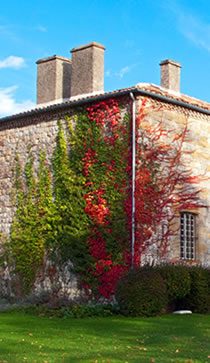A bit of history
The exact time frame in which the castle was built remains unknown but it definitely goes back to medieval era. At less than 500 meters you can find the impressive ruins of the Roman/Gothic Benedictine church and, not far away in the region, are the fortress, typical of this area, (such as Lamontjoie, Fources, La Romieu, etc) and the Roman/Gallic sites of Seviac and Castelculier.
What we know for sure is that in 1094, at the time in which the monastery of Cazeau and its church were passing under the sovereignty of Cluny, Chateu d'Augè has already been built, with its four towers and that, during the following years, two machicolations were added to protect the entrance.
Nowadays, the monastery is not there anymore while the church has lost its roof and Augè some of its towers but still preserve its charismatic and grandiose appearance, together with its long alley linking these two milestones of history. There are legends about a secret passage between the Chateau and the Monastery, allowing the monks to reach safety in case of attacks, attacks frequent at the time in which all the Region was devastated by Viking attacks and lootings.
Again, during the Religion Wars, Augè was on the front line and was, therefore, more of a fortress than of a castle; at that time it was composed of a main hall for the men at the first floor while the women were accommodated on the second floor.
As a matter of fact, it was a woman that, at the beginning of the 18th century, bored by the austere character of the fortress, decided to transform Augè into a more comfortable residence.
Augustine De Montaut Saint Sivier got married to Jean de Fabry, Lord of Augè and Martet, who accepted to modify the Chateau in accordance to the desires of his young wife; the castle was lowered by one floor, two wings were built, one for each side (north and south) and the interiors were re-furbished to the taste and style of the 18th century. The final result was as Augè appear to you today. The main entrance and the stone staircase in the entrance hall go back to the same period.
Among the aristocratic families which spent part of their life at Augè there was the de Faudoas family which was related to Charles the 3rd, King of France who, became himself an "habituè" of Augè, and was used to admire and enjoyed the Gascony hills view from the top of the tower.
The exact time frame in which the castle was built remains unknown but it definitely goes back to medieval era. At less than 500 meters you can find the impressive ruins of the Roman/Gothic Benedictine church and, not far away in the region, are the fortress, typical of this area, (such as Lamontjoie, Fources, La Romieu, etc) and the Roman/Gallic sites of Seviac and Castelculier.
What we know for sure is that in 1094, at the time in which the monastery of Cazeau and its church were passing under the sovereignty of Cluny, Chateu d'Augè has already been built, with its four towers and that, during the following years, two machicolations were added to protect the entrance.
Nowadays, the monastery is not there anymore while the church has lost its roof and Augè some of its towers but still preserve its charismatic and grandiose appearance, together with its long alley linking these two milestones of history. There are legends about a secret passage between the Chateau and the Monastery, allowing the monks to reach safety in case of attacks, attacks frequent at the time in which all the Region was devastated by Viking attacks and lootings.
Again, during the Religion Wars, Augè was on the front line and was, therefore, more of a fortress than of a castle; at that time it was composed of a main hall for the men at the first floor while the women were accommodated on the second floor.
As a matter of fact, it was a woman that, at the beginning of the 18th century, bored by the austere character of the fortress, decided to transform Augè into a more comfortable residence.
Augustine De Montaut Saint Sivier got married to Jean de Fabry, Lord of Augè and Martet, who accepted to modify the Chateau in accordance to the desires of his young wife; the castle was lowered by one floor, two wings were built, one for each side (north and south) and the interiors were re-furbished to the taste and style of the 18th century. The final result was as Augè appear to you today. The main entrance and the stone staircase in the entrance hall go back to the same period.
Among the aristocratic families which spent part of their life at Augè there was the de Faudoas family which was related to Charles the 3rd, King of France who, became himself an "habituè" of Augè, and was used to admire and enjoyed the Gascony hills view from the top of the tower.


